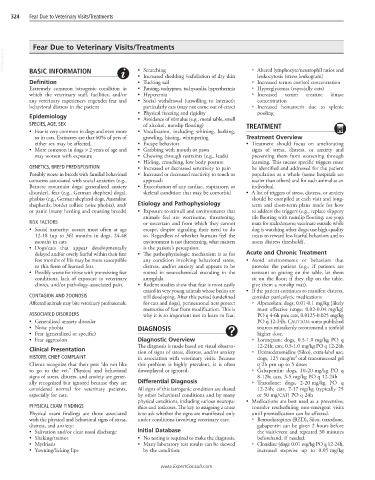Page 703 - Cote clinical veterinary advisor dogs and cats 4th
P. 703
324 Fear Due to Veterinary Visits/Treatments
Fear Due to Veterinary Visits/Treatments
VetBooks.ir
• Scratching
BASIC INFORMATION
leukocytosis (stress leukogram)
• Increased shedding /exfoliation of dry skin ○ Altered lymphocyte/neutrophil ratios and
Definition • Tucking tail ○ Increased serum cortisol concentration
Extremely common iatrogenic condition in • Panting, tachypnea, tachycardia, hyperthermia ○ Hyperglycemia (especially cats)
which the veterinary staff, facilities, and/or • Hyperemia ○ Increased serum creatine kinase
any veterinary experiences engender fear and • Social withdrawal (unwilling to interact); concentration
behavioral distress in the patient particularly cats (may not come out of crate) ○ Increased hematocrit due to splenic
• Physical freezing and rigidity pooling
Epidemiology • Avoidance of stimulus (e.g., metal table, smell
SPECIES, AGE, SEX of alcohol, nonslip flooring) TREATMENT
• Fear is very common in dogs and even more • Vocalization, including whining, barking,
so in cats. Estimates are that 60% of pets of growling, hissing, whimpering Treatment Overview
either sex may be affected. • Escape behaviors • Treatment should focus on ameliorating
• More common in dogs > 2 years of age and • Grabbing with mouth or paws signs of stress, distress, or anxiety and
may worsen with exposure • Chewing through restraints (e.g., leads) preventing them from worsening through
• Hiding, crouching, low body posture learning. This means specific triggers must
GENETICS, BREED PREDISPOSITION • Increased or decreased sensitivity to pain be identified and addressed for the patient
Possibly worse in breeds with familial behavioral • Increased or decreased reactivity to touch or population as a whole (some hospitals are
concerns associated with social anxieties (e.g., approach scarier than others) and for each animal as an
Bernese mountain dogs: generalized anxiety • Exacerbation of any cardiac, respiratory, or individual.
disorder), fear (e.g., German shepherd dogs), skeletal condition that may be comorbid • A list of triggers of stress, distress, or anxiety
phobias (e.g., German shepherd dogs, Australian should be compiled at each visit and long-
shepherds, border collies: noise phobia), and/ Etiology and Pathophysiology term and short-term plans made for how
or panic (many herding and coursing breeds) • Exposure to stimuli and environments that to address the triggers (e.g., replace slippery
animals feel are worrisome, threatening, tile flooring with nonslip flooring; use yoga
RISK FACTORS or uncertain and from which they cannot mats for scales/exams; vaccinate outside while
• Social maturity: occurs most often at age escape, despite signaling their need to do dog is watching other dogs; use high-quality
12-18 (up to 36) months in dogs, 24-48 so. Regardless of whether humans feel the treats to reward less fearful behaviors and to
months in cats environment is not threatening, what matters assess distress threshold).
• Dogs/cats that appear developmentally is the patient’s perception.
delayed and/or overly fearful within their first • The pathophysiologic mechanism is as for Acute and Chronic Treatment
few months of life may be more susceptible any condition involving behavioral stress, • Avoid environments or behaviors that
to this form of learned fear. distress, and/or anxiety and appears to be provoke the patient (e.g., if patients are
• Possibly worse for those with pre-existing fear rooted in neurochemical encoding in the resistant to getting on the table, let them
conditions, lack of exposure to veterinary amygdala. sit on the floor; if they slip on the table,
clinics, and/or pathology-associated pain. • Rodent studies show that fear is most easily give them a nonslip mat).
erased in very young animals whose brains are • If the patient continues to manifest distress,
CONTAGION AND ZOONOSIS still developing. After this period (undefined consider panicolytic medications
Affected animals may bite veterinary professionals. for cats and dogs), perineuronal nets protect ○ Alprazolam: dogs, 0.01-0.1 mg/kg [likely
memories of fear from modification. This is most effective range: 0.02-0.04 mg/kg]
ASSOCIATED DISORDERS why it is so important not to learn to fear. PO q 4-6h prn; cats, 0.0125-0.025 mg/kg
• Generalized anxiety disorder PO q 12-24h. CAUTION: some published
• Noise phobia DIAGNOSIS sources mistakenly recommend a tenfold
• Fear (generalized or specific) higher dose.
• Fear aggression Diagnostic Overview ○ Lorazepam: dogs, 0.5-1.0 mg/kg PO q
The diagnosis is made based on visual observa- 12-24h; cats, 0.5-1.0 mg/kg PO q 12-24h
Clinical Presentation tion of signs of stress, distress, and/or anxiety ○ Dexmedetomidine (Sileo), extra-label use;
HISTORY, CHIEF COMPLAINT in association with veterinary visits. Because dogs, 125 mcg/m oral transmucosal gel
2
Clients recognize that their pets “do not like this problem is highly prevalent, it is often q 2h prn up to 5 doses
to go to the vet.” Physical and behavioral downplayed or ignored. ○ Gabapentin: dogs, 10-20 mg/kg PO q
signs of stress, distress, and anxiety are gener- 8-12h; cats, 3-5 mg/kg PO q 12-24h
ally recognized but ignored because they are Differential Diagnosis ○ Trazodone: dogs, 2-20 mg/kg PO q
considered normal for veterinary patients, All signs of this iatrogenic condition are shared 12-24h; cats, 7-17 mg/kg (typically 25
especially for cats. by other behavioral conditions and by many or 50 mg/CAT) PO q 24h
physical conditions, including various neuropa- • Medications are best used as a preventive;
PHYSICAL EXAM FINDINGS thies and toxicoses. The key to assigning a cause consider rescheduling non-emergent visits
Physical exam findings are those associated is to ask whether the signs are manifested only until premedication can be affected.
with the physical and behavioral signs of stress, under conditions involving veterinary care. ○ Benzodiazepines (BZD), Sileo, trazodone,
distress, and anxiety: gab apentin can be given 2 hours before
• Salivation and/or clear nasal discharge Initial Database the visit/event and repeated 30 minutes
• Shaking/tremor • No testing is required to make the diagnosis. beforehand, if needed.
• Mydriasis • Many laboratory test results can be skewed ○ Clonidine (dogs: 0.01 mg/kg PO q 12-24h,
• Yawning/licking lips by the condition: increased stepwise up to 0.05 mg/kg
www.ExpertConsult.com

